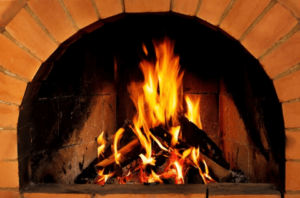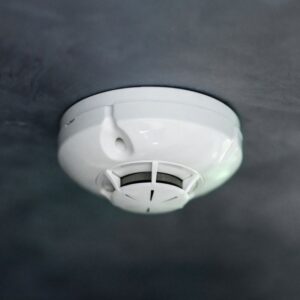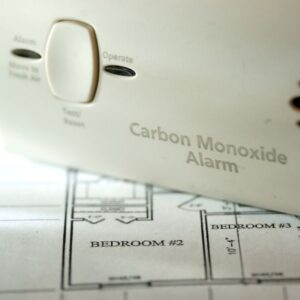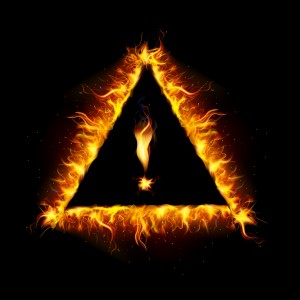URGENT!
Due to the weather, we are experiencing intermittent power outage and loss of internet. Please expect delays and or rescheduling of appointments during this time. We will reach out to you as soon as we can. Stay warm and stay safe!
Every chimney need maintenance before the start of the burning season, but many homeowners choose to opt out. Why? Well, some blame time constraints or budget issues, but the truth is a lot of people just simply forget to schedule a inspection and a cleaning.
Unfortunately, this triggers a lot of issues down the line, making one’s home less safe. Learn more about the hazards involved by reading below, then contact our team to get an appointment on the books today. We take pride in making homes all throughout the area as safe as possible year after year!
 When you neglect to schedule an annual sweeping, a substance called creosote builds up in your system’s interior. Creosote comes in a few different forms – light and flaky, sticky and tar-like, or hard and glossy. Creosote is also very flammable. When a lot of it accumulates inside your chimney, you face an increased risk of experiencing a chimney fire.
When you neglect to schedule an annual sweeping, a substance called creosote builds up in your system’s interior. Creosote comes in a few different forms – light and flaky, sticky and tar-like, or hard and glossy. Creosote is also very flammable. When a lot of it accumulates inside your chimney, you face an increased risk of experiencing a chimney fire.
The intense heat from a chimney fire can trigger a lot of damage throughout your chimney. Your brickwork and mortar will weaken significantly, and holes and cracks will form throughout your chimney structure. This obviously makes it quite dangerous to light fires, as flames and fumes can easily escape through these openings into your living space.
Unfortunately, chimney fires aren’t typically loud and obvious, like most people assume. Many people have continued using a damaged chimney because they don’t realize anything has occurred! This is another reason why you should get an inspection and cleaning scheduled with the professionals. Call today to work with our qualified, confident, and professional team.
If you’re eager to light fires for Thanksgiving and Christmas, then let us come and check for repairs and build up. We’ll ensure everything is in tip-top shape and ready to go, so you can light fires with confidence and peace of mind. Your guests and family members will appreciate the extra comfort, too!
The team at Lords Chimney takes your safety seriously. We love serving customers all throughout the area, and we’re certain there is no better team to trust with your chimney and fireplace than us. We strive to stay educated on all of the latest techniques and technologies in the field. Our certifications with the CSIA and the NFI help us stay up-to-date on everything we need to know to keep your chimney in the best shape possible.
Ready to get started? We can’t wait to help you with all of your chimney and fireplace needs!
If you are buying a home, scheduling a home inspection is a necessary step in the process. Yet, many home buyers mistakenly believe a home inspection includes a thorough and in-depth look at the fireplace and chimney. This is not the case! Home inspectors are not actually required to inspect various parts of your chimney. This means you could be missing out on important information regarding your potential home purchase.
Some of things home inspectors are not required to inspect are seals, gaskets, doors, vents, and any interiors that are not easy to access. Their standard of practice states that anything not “readily accessible” does not need to be inspected. That means the interior of the chimney itself was likely not even looked at!
While home inspections are beneficial in many ways, hiring a certified chimney tech to inspect your fireplace and determine whether or not it is safe for regular use is necessary for making a smart decision when seeking out your new home.
At Lords Chimney, we are CSIA certified, which means we can perform top quality inspections, no matter what your fireplace needs. When the technician comes to your home, they will perform either a level I, a level II, or a level III inspection. Learn more about these below!
Level One – A level one inspection occurs when you have had no major issues or changes with your fireplace throughout the past year. This inspection is a basic overview of all the parts. We check to ensure everything is running smoothly and that no obvious repairs are necessary. Also, we will determine whether or not a sweeping is in order and will make sure the venting systems are clear.
Level Two – Level two inspections are a bit more extensive. A camera will be used to check the interior systems. We will check for water damage, correct measurements, chimney caps, and more. These types of inspections are for buying and selling homes or for when a chimney has faced damage or recent renovations.
Level Three – Level three inspections are less common and are done when more widespread damage is discovered. Certain parts of the chimney may need to be removed for us to discover the issue and resolve it.
Knowing what to expect from your chimney company can be tricky. If you have any questions at all, feel free to give the staff at Lords Chimney a call 281-497-4000. We will be more than happy to assist you. We will provide you with all of the answers and advice you are looking for.
A deadly toxic gas that can enter your home if you have venting problems with your chimney or other heating unit, carbon monoxide is responsible for killing over 400 Americans by unintentional poisoning annually.
According to the Centers for Disease Control and Prevention (CDC), carbon monoxide poisoning also sends over 20,000 people to the emergency room, and more than 4,000 people end up having to be hospitalized due to carbon monoxide poisoning. This is why it’s very important to have your chimney inspected annually to ensure your chimney system is venting properly.
Our Chimney Safety Institute of America-certified technicians, who are experienced with solving carbon monoxide issues, would like to tell you more about this toxic gas that can silently enter your home and cause serious health damage…
 Carbon monoxide is a colorless, odorless, tasteless, and extremely toxic gas that is produced by burning fuels. Carbon monoxide is often called the “silent killer” because due to its properties, it is impossible to detect without specific equipment.
Carbon monoxide is a colorless, odorless, tasteless, and extremely toxic gas that is produced by burning fuels. Carbon monoxide is often called the “silent killer” because due to its properties, it is impossible to detect without specific equipment.
Carbon monoxide is produced by the incomplete combustion of fuels, including the wood, natural gas, or propane you use to heat your home. Depending on the type of heating appliance you have, your appliance may either burn hot enough to combust all traceable levels of carbon monoxide, or it will be vented out of your home through a chimney or ventilation system. If a ventilation system becomes blocked, such as from soot, debris, or nesting animals, carbon monoxide can be forced back into your home rather than exiting through the chimney or ductwork. A malfunctioning appliance also can cause a carbon monoxide hazard.
Its many sources include burning coal, wood, charcoal, oil, natural gas, kerosene, and propane. This means that most fireplaces, stoves, grills, space heaters, water heaters, furnaces, and even vehicles produce carbon monoxide gas. However, these appliances are normally either properly vented or located outdoors so they pose little to no risk to homeowners and their families.
Headache, dizziness, nausea, vomiting, weakness, chest pain, and confusion are all symptoms of low-level carbon monoxide poisoning. Since these symptoms are so similar to the flu or the common cold, carbon monoxide poisoning can be difficult to diagnose.
If you believe that you are experiencing the symptoms of carbon monoxide poisoning, immediately move to a fresh air location. Ideally this is outside, but can also be next to an open door or window. Call Poison Control and local emergency services before reentering the building.
If you persist in having these symptoms, ask your doctor for a carbon monoxide level blood test. High-level symptoms include organ damage, loss of consciousness, and death.
For some reason, your red blood cells would rather pick up carbon monoxide than oxygen. If there is a lot of carbon monoxide in the air, your body may replace all of the oxygen in your blood with carbon monoxide, blocking oxygen from entering your body, causing tissue damage and resulting, possibly, in death. Tissues can also be destroyed by carbon monoxide teaming up with the proteins in tissues.
 Have your fireplace and chimney cleaned and inspected by a reputable chimney company like Lords Chimney every year.
Have your fireplace and chimney cleaned and inspected by a reputable chimney company like Lords Chimney every year.Firstly, never burn anything in a fireplace that is not vented. Secondly, never patch a vent pipe with tape, gum, or anything else, which could cause carbon monoxide to build up more quickly. Thirdly, your indoor vent pipes should go up slightly as they go towards the outside. This helps prevent toxic gases from leaking if the joints or pipes are not fitted properly.
If you have any more questions about carbon monoxide, contact us today. Our experienced staff can answer whatever else you need to know about the dangers of carbon monoxide poisoning.
Everything You Need to Know About Creosote
What is Creosote?
Creosote is a chemical byproduct that is produced after the distillation of tar. So when wood is burned, creosote is produced. It is known for its preservative properties and for being anti-septic. There are basically two types of creosote; the wood-tar, and the coal-tar. The wood-tar creosote, being less toxic, is commonly used in meat preservation, wood treatment and for medicinal purposes. When used medicinally, it is commonly utilized as an astringent, anesthetic, expectorant, laxative and anti-septic. The coal-tar creosote is more commonly used in wood preservation because of its toxic properties.

In its early stages of accumulation, creosote is flaky. As it left to build…it becomes more tar-like. All creosote is highly flammable.
Creosote in Chimney
There are several stages that the creosote in your chimney that you may experience. First is its’ soot: a flaky form that is easy to remove leaving the flue walls unobstructed. Second: the stage where it leaves brittle and hard deposits that are a bit more difficult to remove. The third is the glazed stage where it becomes dangerous and much more difficult to remove. Once you notice the dense, dark and shiny tar-like appearance, then this would indicate that the creosote has reached its glazed stage. There will always be some level of creosote in your chimney – as it is a natural byproduct of burning, but it doesn’t need to be left to accumulate.
Possible Dangers
The longer creosote is ignored…the greater the possible danger. Creosote is highly flammable and is a leading cause of chimney fires. You may see products, such as a log that is supposed to remove creosote while burning. Not only is this difficult to gauge in its effectiveness, it may also cause chunks of creosote to fall down your flue and get stuck along the way. Because of the fire risk, you should leave creosote removal to a professional.
Preventive Measures
To avoid higher risk for a catastrophe, don’t wait for your chimney to reach a disastrous level of creosote build-up. It is best to schedule regular chimney inspections and sweeping on an annual basis. This way you know you are not letting the buildup become a hazard. This also prolongs your chimney’s lifespan.
We hope that this has been helpful and sufficient in answering your questions about creosote. So now you are fully equipped with the knowledge to better protect and improve your home. If you have a chimney, make sure to have it checked regularly and make it a habit to schedule a regular inspection and sweeping by a chimney professional.